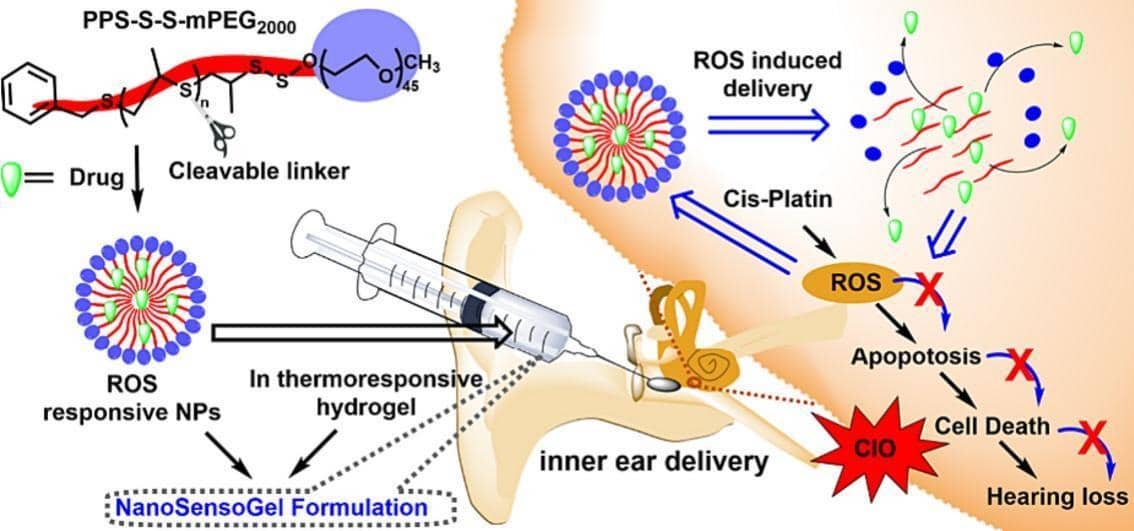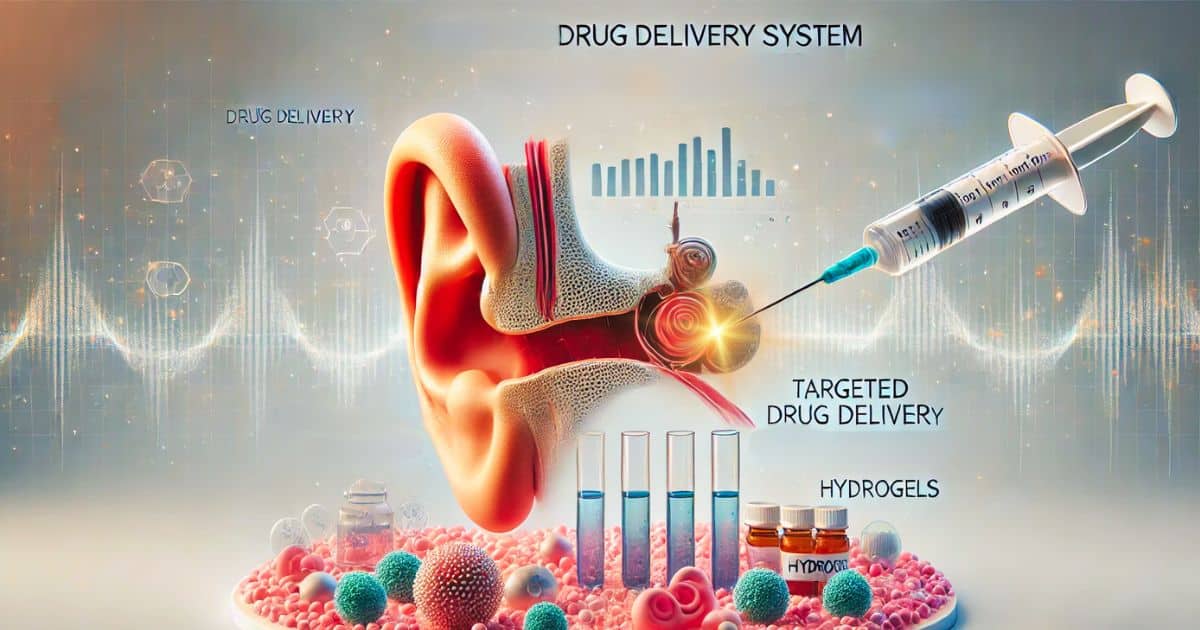OKLAHOMA CITY, OK — Cisplatin, a widely used chemotherapy drug, has been a crucial treatment for many cancer patients, but its effectiveness often comes with a significant downside: irreversible hearing loss. Particularly pronounced in children, this side effect can drastically reduce quality of life, affecting learning and development.
However, researchers at the University of Oklahoma, led by Dr. Vibhuti Agrahari, have developed a novel drug delivery system that may prevent this hearing damage. The innovation was recently detailed in two studies published in the Journal of Controlled Release and Journal of Nanobiotechnology.
Cisplatin and Its Impact on Hearing

Vibhuti Agrahari, Ph.D., is an assistant professor in the OU College of Pharmacy. Image credit: Univ. Oklahoma
Cisplatin enters the bloodstream during chemotherapy and accumulates in the cochlea, a crucial organ in the inner ear responsible for interpreting sound. The drug remains there for months, where it damages delicate hair cells critical for hearing. These cells do not regenerate once destroyed, leading to permanent hearing loss, which is particularly concerning for children undergoing cognitive development.
The challenge of mitigating this hearing loss inspired Dr. Agrahari, an assistant professor at the University of Oklahoma College of Pharmacy, to focus on a prophylactic solution that targets the inner ear directly.
“We wanted to create a targeted drug delivery approach that could prevent hearing loss before it begins, rather than relying on interventions like hearing aids or cochlear implants,” Agrahari stated.
A Novel Approach to Drug Delivery
The innovative drug delivery system developed by Agrahari and her team centers around hydrogels, a water-based substance that transitions from liquid to gel at body temperature, ensuring a localized and prolonged drug release in the inner ear. Embedded within the hydrogel are nanoparticles, each about 100 nanometers wide. These nanoparticles carry cytoprotective drugs that counteract the harmful effects of cisplatin on the hair cells in the cochlea.
In the first of two published studies, the research team employed a quality-by-design approach to optimize the formulation of nanoparticles embedded in the hydrogel, co-encapsulating two therapeutic agents:
- Flunarizine (a calcium channel blocker)
- Honokiol (a natural antioxidant)
These drugs were selected for their protective effects on the hair cells, with Flunarizine mitigating calcium damage and Honokiol reducing oxidative stress, both key contributors to hearing loss.
Positive Early Results
Dr. Agrahari’s team tested this delivery system in laboratory models using inner ear cell lines. The results showed promising cytoprotective effects, with the combination of Flunarizine and Honokiol providing significant protection against cisplatin-induced damage. This combination was found to be even more effective than current treatments, such as sodium thiosulfate, which was recently approved by the FDA for cisplatin-induced hearing loss in children.
The second study built upon this work by using zebrafish models to demonstrate the system’s ability to protect hair cells in vivo. In this model, the team showed that their nanoparticle delivery system significantly reduced hair cell damage in the cochlea when exposed to cisplatin, a critical finding that supports the translational potential of this research for human use.

Credit: Thakur, N., et al. (2024) Dual stimuli-responsive and sustained drug delivery NanoSensoGel formulation for prevention of cisplatin-induced ototoxicity. Journal of Controlled Release
Stability and Precision
The drug-loaded nanoparticles were engineered using an advanced design of experiment (DoE) approach. This method allowed the team to optimize key factors such as nanoparticle size, drug encapsulation efficiency, and release kinetics. The nanoparticles are designed to release the drugs slowly over time, providing sustained protection to the hair cells.
In addition, the hydrogel ensures that the nanoparticles stay in place within the inner ear, preventing them from leaking into the surrounding tissues.
Tests also confirmed that the formulation remained stable in solution for more than 60 days, ensuring it could be a viable option for clinical use. The researchers further demonstrated that the hydrogel system could deliver its protective drugs for over a month, maintaining a steady release rate and ensuring prolonged protection during the vulnerable period of cisplatin treatment.
Looking Ahead
The results from both studies provide a foundation for further development, with patents already filed for the novel delivery system. The next phase involves additional testing in animal models and, eventually, human trials. While still in its early stages, this research could dramatically improve the lives of cancer patients, particularly children, by allowing them to undergo lifesaving chemotherapy without sacrificing their hearing.
“There is immense potential for this system. We are focused on developing an efficient and safe delivery mechanism that can directly address the issue of chemotherapy-induced hearing loss. Our goal is to protect patients from the outset and improve their quality of life after cancer treatment.”
–Dr. Vibhuti Agrahari
With continued support from the Presbyterian Health Foundation, Capita Foundation Auditory Research Grant, and the University of Oklahoma College of Pharmacy, the team is optimistic that their novel drug delivery system will be a breakthrough in the fight against chemotherapy-induced ototoxicity.
About the project
The two studies are titled, “Cross-linked hybrid nanoparticle embedded in thermogel for sustained co-delivery to inner ear” (https://doi.org/10.1186/s12951-024-02686-z) and “Dual stimuli-responsive and sustained drug delivery NanoSensoGel formulation for prevention of cisplatin-induced ototoxicity” (https://doi.org/10.1016/j.jconrel.2024.02.005). The studies were supported by awards from the Presbyterian Health Foundation, Capita Foundation Auditory Research Grant and the OU College of Pharmacy.
About the University of Oklahoma
Founded in 1890, the University of Oklahoma is a public research university located in Norman, Oklahoma. The institution is dedicated to addressing the educational, cultural, economic, and health care needs of the state, region, and nation. OU has been recognized as Oklahoma’s top university by U.S. News & World Report.
References
- Thakur, N. S., Rus, I., Herbert, A., Zallocchi, M., Chakrabarty, B., Joshi, A. D., Lomeo, J., & Agrahari, V. (2024). Cross-linked hybrid nanoparticle embedded in thermogel for sustained co-delivery to inner ear. Journal of Nanobiotechnology, 22(1), 482. https://doi.org/10.1186/s12951-024-02686-z
- Agrahari, V., & Chakrabarty, B. (2024). Dual stimuli-responsive and sustained drug delivery NanoSensoGel formulation for prevention of cisplatin-induced ototoxicity. Journal of Controlled Release, 345, 85-99. https://doi.org/10.1016/j.jconrel.2024.02.005
Source: OU






